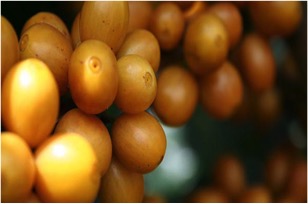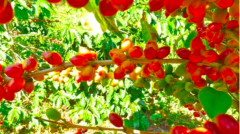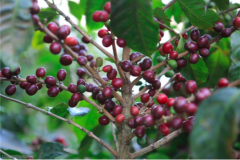Coffee World Map--Introduction to Rwandan Coffee Development, Processing and Varieties

For professional baristas, please follow the coffee workshop (Wechat official account cafe_style)
Rwandan coffee is the most popular African coffee after Kenya and Ethiopia. But unlike the two famous producing countries, it does not have a long history of planting, let alone native varieties everywhere in the wild. This small African country is a fire Phoenix that has been reborn after robbery.
Rwanda (Rwanda), known as the Land of a Thousand Hills, sits above the equator and is surrounded by East African States such as Congo, Uganda, Tanzania and Burundi. Geographically, it has suitable conditions for growing coffee, but since it was introduced by German missionaries in 1904, Rwandan coffee has been poorly handled commercial grade, most of which have been exported to the sovereign country of Belgium. The promotion of boutique coffee production began only after the ravages of war and after the economy got back on track.
The genocide (Genocide), which occurred in 1994, killed more than 1 million people, most of them Tutsi (Tutsi). So far, there are orphans who survived that year, memorial halls that can be seen everywhere, and war criminals who account for 90% of the total number of prisoners in the streets of Rwanda. Since 2001, the Government of Rwanda has established NAEB (National Agriculture Export Development Board), which focuses on promoting coffee exports and earning foreign exchange.
With the support of the government, farmers have changed from rough home treatment to transporting freshly harvested fruit to a nearby water washing station (Coffee Washing Station) for full washing treatment. In a short period of 12 years, the number of washing stations across the country has increased from two to 220. It is now all private, that is, owned by exporters or farmers' cooperatives. Due to the small average area of farmland (less than 200 coffee trees per farm), about 50 to 100 farms are served at each station. NAEB employs 200 botanists and cup surveyors to regularly check quality at washing stations and educate farmers about soil management, organic planting, pruning, disinfestation and picking.
Strictly control the speed of air drying
Bourbon accounts for more than 90% of Rwanda's production. A small number of farmers grow bourbon variants BM-139 and Jackson. There are more mountains in the south and west, and water washing stations are also more famous. For example, Gitesi, Huye Mountain, Mibirizi, etc. Compared with drying on concrete in Central America, Rwanda will cover parchment coffee on an African bed with canvas to control the rate of air drying and slowly reduce the water content of the beans to 11% of the target in 10 to 15 days. Compared with sunlight exposure, this method helps to retain organic matter.
Rwanda is the first African country to host COE events. This is the fifth year. In taste, Rwanda coffee has obvious floral and fruity aromas, and tastes as smooth as tea. The balance is the highest in the United States of Africa. The author's participation in this year's competition and feelings will be discussed in a separate article.
Patrick Tam (owner of the boutique coffee shop Knockbox, approved barista of the American Fine Coffee Association and European Fine Coffee Association, CQI recognized cup tester, Cup of Excellence's first Hong Kong judge)
Important Notice :
前街咖啡 FrontStreet Coffee has moved to new addredd:
FrontStreet Coffee Address: 315,Donghua East Road,GuangZhou
Tel:020 38364473
- Prev

Coffee World Map-Guatemala Flavor Characteristics, Growing Environment and Awards
Professional barista exchanges, please pay attention to coffee workshop (Weixin Official Accounts cafe_style ) Guadi is the nickname of coffee friends for Guatemala (also translated Guatemala). This Mayan city sits atop 37 volcanoes, two of which erupted in 2010. With frequent tornadoes and natural disasters everywhere, it is a veritable dangerous place. But fertile volcanoes
- Next

Coffee World Map-- Kenya Coffee famous Coffee auction and COE
The exchange of professional baristas please follow the coffee workshop (Wechat official account cafe_style), which is the basic belief of the coffee boutique movement that allows farmers to earn what they deserve. Although Cup of Excellence is currently the most representative and transparent competition in the industry, many of the details are actually modelled on Kenya's world-famous coffee auction (Kenya Coffee) since the 1930s.
Related
- Does Rose Summer choose Blue, Green or Red? Detailed explanation of Rose Summer Coffee plots and Classification in Panamanian Jade Manor
- What is the difference between the origin, producing area, processing plant, cooperative and manor of coffee beans?
- How fine does the espresso powder fit? how to grind the espresso?
- Sca coffee roasting degree color card coffee roasting degree 8 roasting color values what do you mean?
- The practice of lattes: how to make lattes at home
- Introduction to Indonesian Fine Coffee beans-- Java Coffee producing area of Indonesian Arabica Coffee
- How much will the flavor of light and medium roasted rose summer be expressed? What baking level is rose summer suitable for?
- Introduction to the characteristics of washing, sun-drying or wet-planing coffee commonly used in Mantenin, Indonesia
- Price characteristics of Arabica Coffee Bean Starbucks introduction to Manning Coffee Bean Taste producing area Variety Manor
- What is the authentic Yega flavor? What are the flavor characteristics of the really excellent Yejasuffi coffee beans?

